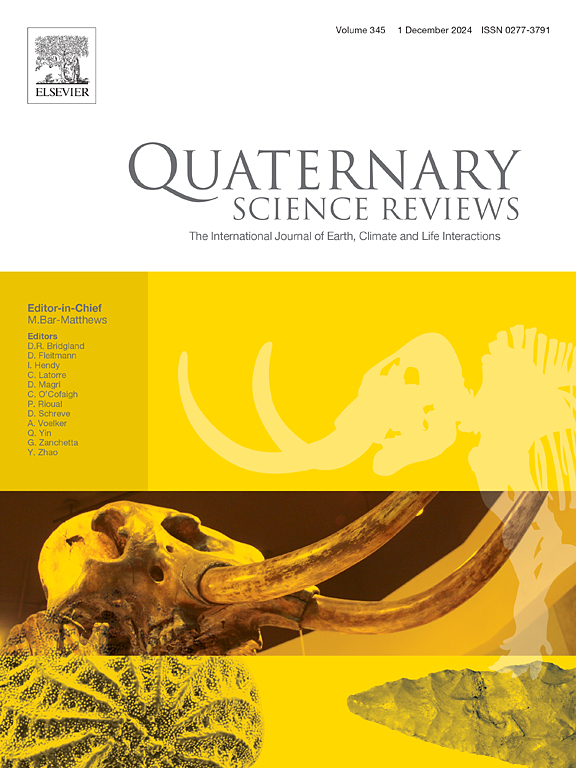Ocean surface conditions during Holocene Thermal Maximum in Kongsfjorden, Svalbard, and its relevance for understanding modern warming in the region
IF 3.2
1区 地球科学
Q1 GEOGRAPHY, PHYSICAL
引用次数: 0
Abstract
The Holocene Thermal Maximum (HTM) is a significant warm period of the Holocene epoch, occurring between 11 and 6 ka BP. Here we present a multidecadal-to-centennial scale resolution diatom-based quantitative reconstruction of August Sea surface temperature (aSST) from Kongsfjorden, Svalbard for the regional HTM period between 10.5 and 7.5 ka BP. We find highly variable and moderately warm surface conditions with periods of colder aSST and/or seasonal sea ice presence. Based on the reconstruction, we infer that the variability of local surface conditions during HTM was mainly influenced by insolation and glacier/sea ice melt along with changes in the proximity of oceanic frontal zones, while influence of Atlantic Water at the surface was limited. The reconstructed aSST of 3.7 °C on average for the reconstructed part of the HTM period and 4.2 °C for its warmest interval between 10.5 and 10.1 ka BP are comparable within the method uncertainty to summer sea surface temperatures observed in the area today. We further present the evidence that the diatom assemblages are preserved in the sedimentary sequence for the first time in the record during the HTM and then re-emerge only in the core top sediments, suggesting some similarity in the environmental conditions in Kongsfjorden between the modern period and the HTM.

斯瓦尔巴群岛kongsjorden全新世热极大期海洋表面条件及其与理解该地区现代变暖的相关性
全新世热极大期(HTM)是全新世的一个重要暖期,发生在11 ~ 6 ka BP之间。本文对斯瓦尔巴群岛Kongsfjorden地区HTM时期10.5 ~ 7.5 ka BP的8月海面温度进行了多年至百年际分辨率硅藻定量重建。我们发现高度变化和适度温暖的地表条件与较冷的时期和/或季节性海冰的存在。基于重建,我们推断HTM期间局地地表条件的变率主要受日晒和冰川/海冰融化以及海洋锋面区接近度变化的影响,而大西洋水对表层的影响有限。在方法不确定度范围内,HTM时期重建部分的平均温度为3.7°C,最暖区间(10.5 ~ 10.1 ka BP)的平均温度为4.2°C,与该地区今天观测到的夏季海面温度相当。我们进一步提出了在热沉积时期,硅藻组合在沉积序列中首次被保存下来的证据,然后只在岩心顶部沉积物中重新出现,这表明现代时期和热沉积时期Kongsfjorden的环境条件有一定的相似性。
本文章由计算机程序翻译,如有差异,请以英文原文为准。
求助全文
约1分钟内获得全文
求助全文
来源期刊

Quaternary Science Reviews
地学-地球科学综合
CiteScore
7.50
自引率
15.00%
发文量
388
审稿时长
3 months
期刊介绍:
Quaternary Science Reviews caters for all aspects of Quaternary science, and includes, for example, geology, geomorphology, geography, archaeology, soil science, palaeobotany, palaeontology, palaeoclimatology and the full range of applicable dating methods. The dividing line between what constitutes the review paper and one which contains new original data is not easy to establish, so QSR also publishes papers with new data especially if these perform a review function. All the Quaternary sciences are changing rapidly and subject to re-evaluation as the pace of discovery quickens; thus the diverse but comprehensive role of Quaternary Science Reviews keeps readers abreast of the wider issues relating to new developments in the field.
 求助内容:
求助内容: 应助结果提醒方式:
应助结果提醒方式:


